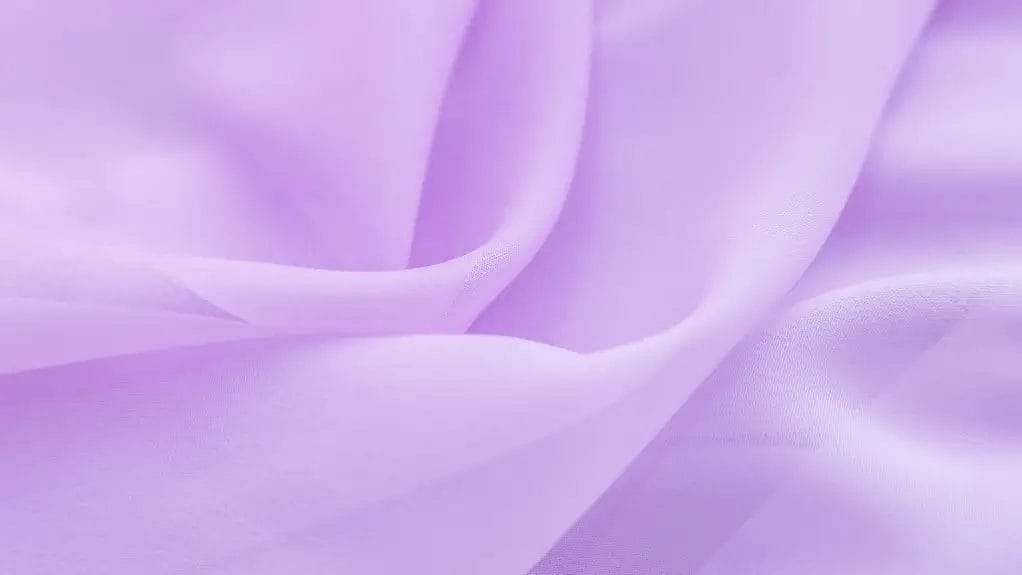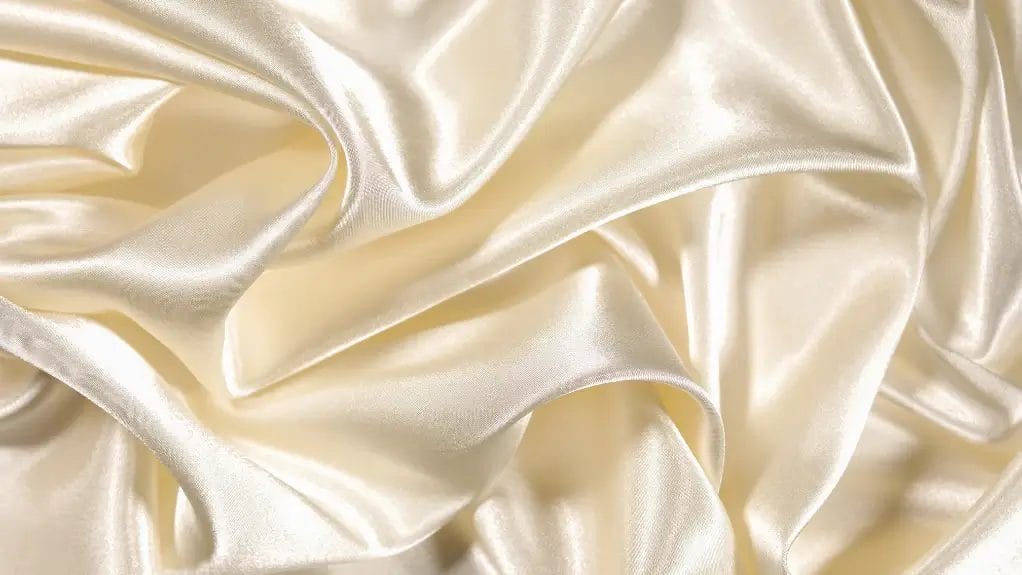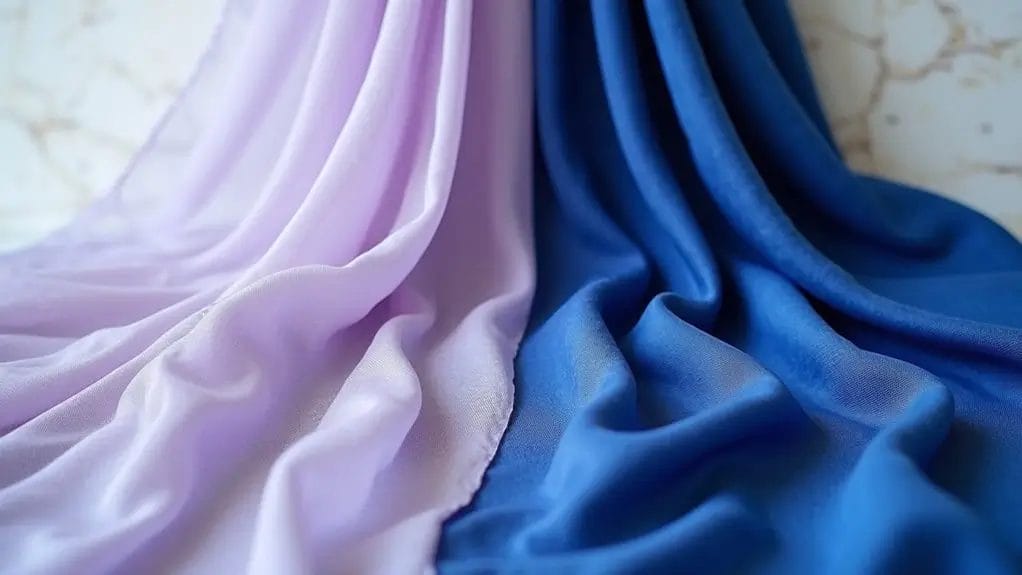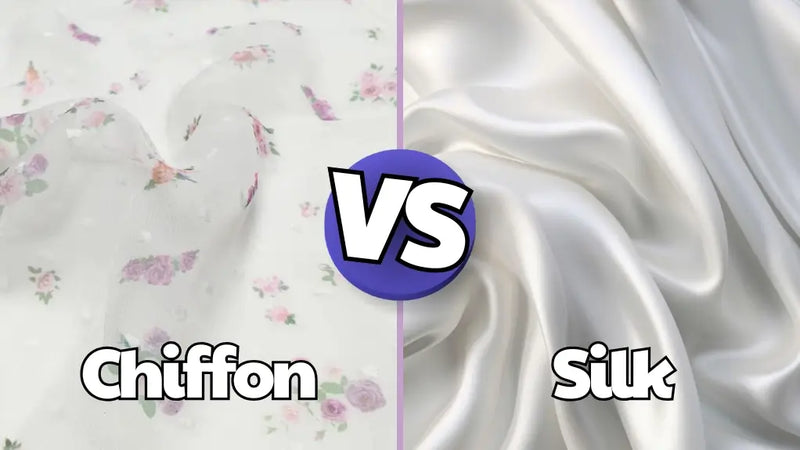When comparing chiffon vs silk, you're picking elegant fabrics for special looks. Chiffon, a sheer, lightweight material often made from synthetic fibers like polyester, offers a floaty drape perfect for summer dresses or wedding veils, but it snags easily.
Silk, a natural fiber from silkworms, feels smoother, lasts longer with care, and shines in luxury gowns or scarves. Stick around to explore which fabric best fits your style and needs!
Key Takeaways
- Chiffon is ideal for lightweight, sheer looks in warm settings, while silk offers a smoother, luxurious feel for elegant occasions.
- Silk lasts longer with proper care, whereas chiffon is prone to snags and less durable.
- Budget matters: silk is typically more expensive than affordable, synthetic chiffon.
- Choose chiffon for breathable summer dresses; opt for silk for sophisticated evening wear or scarves.
- Consider project needs: silk for skin-friendly texture, chiffon for flowy, dreamy designs.
What Is Chiffon Fabric?

Hey there, let’s talk about chiffon fabric and what makes it special, starting with its history and uses.
Chiffon History and Origins
Curiosity about chiffon fabric leads us straight to its fascinating history. Chiffon comes from the French word “coiffe,” meaning cloth or rag. This term hints at its delicate, airy nature, perfect for elegant designs.
Originally made from silk, chiffon was a luxury fabric in the 18th century. Back then, chiffon was originally made for royalty and high society in France, showcasing its connection to silk.
Now, synthetic chiffon dominates, making it more affordable. Imagine wearing a flowing gown—chiffon’s lightweight feel, rooted in French tradition, still captivates. So, when choosing, consider this historic charm!
Chiffon Production Process
Let's shift from chiffon's historical roots to how it's actually made today.
When you explore chiffon fabric, you’ll see it’s all about the weave—a tight, alternating pattern of S-twist and Z-twist threads.
Originally, chiffon made from silk used delicate silk fibers for a luxurious feel, but now, most chiffon’s crafted with synthetic fibers like nylon or polyester for affordability.
Look at the process: these materials get twisted and woven to create that sheer, floaty look.
You’ve likely seen this in lightweight scarves.
Understanding this helps you pick the right chiffon for your needs.
Chiffon Common Uses
Imagine chiffon as that breezy, feather-light fabric you’ve likely spotted in stunning outfits. It’s a sheer fabric, so lightweight that it feels almost like air. This quality makes chiffon perfect for flowing designs with an elegant drape.
Chiffon garments are often seen in evening wear, bringing breathable comfort to warm nights. Chiffon dresses, especially, showcase this fabric’s elegance with their soft, cascading look.
Think of wedding veils or layered skirts at fancy events. Whether it’s a prom or a gala, chiffon adds a dreamy touch. Its versatility suits scarves and blouses, too, effortlessly enhancing everyday style.
Chiffon Care and Maintenance
Taking care of chiffon fabric can keep your favorite outfits looking fresh and fabulous. Due to its delicate nature, you’ve got to handle chiffon clothing with extra caution. One disadvantage of chiffon is that it is prone to snags.
Here’s how you can maintain it:
- Hand-wash gently: Use cold water and mild detergent, avoiding harsh scrubbing.
- Avoid heat damage: When ironing chiffon, use a steamer or low heat with a cloth.
- Store carefully: Hang or fold to prevent wrinkles, unlike tougher silk garments.
Follow these, and your chiffon stays stunning!
Chiffon Advantages and Disadvantages
While chiffon fabric might look dreamy, it’s got both perks and pitfalls you should know about.
Chiffon is light and breathable, making it perfect for summer dresses.
However, its durability isn’t great; it snags easily.
Consider these key differences when choosing:
- Luxurious Feel: Chiffon offers a delicate look, but silk is more expensive and richer.
- Characteristics of Chiffon: It’s sheer and airy, ideal for flowy scarves.
- Differences Between Silk and Chiffon: Silk lasts longer with care, unlike fragile chiffon.
Understand these points to pick the right fabric. Knowing such details helps in making smart fashion choices.
What Is Silk Fabric?

Next, let’s talk about silk fabric and what makes it so special.
Silk Origins and History
Imagine a fabric so luxurious it's been treasured for thousands of years—silk is exactly that.
You’ve likely heard of silk, a stunning material from ancient China, dating back over 5,000 years.
It started as a secret, reserved for royalty, showcasing raw silk’s unmatched beauty.
This luxurious silk, especially high-quality silk, became a global treasure along the Silk Road.
Silk fabric, such as silk chiffon or silk satin, has long been a symbol of wealth.
Picture wearing a silk gown—its elegance is timeless.
Today, you can still feel that prestige in every piece of silk you touch.
Silk Production Process
The journey of silk fabric starts with a fascinating process rooted in nature. Silk comes from silkworms, tiny creatures spinning cocoons. Silk is renowned for its luxurious feel, setting it apart from other materials.
Dive deeper, and you’re watching farmers nurture silkworms on mulberry leaves. They harvest cocoons, boil them to loosen threads, and weave silk fabrics like silk twill or silk chiffon fabric.
It’s a delicate craft. Silk and chiffon often blend beautifully, creating stunning pieces.
Imagine wearing silk chiffon—smooth and elegant. This process shows why silk holds such timeless value in fashion.
Silk Common Uses
Silk, a treasure of nature, captivates with its elegance and versatility in everyday fashion. It’s a top choice for luxury clothing.
As a textile, silk transforms into stunning pieces. Think of a flowing silk scarf or a sleek garment like a dress.
You’ve likely seen silk in wedding gowns or ties, too. It’s perfect for special occasions and adds sophistication to your style.
Silk Care and Maintenance
Discover the essentials of caring for silk, a delicate yet stunning fabric. If you’ve chosen silk over chiffon in the chiffon vs silk debate, you’ll need to know proper care.
Compared to silk, wearing chiffon might seem easier, but silk’s elegance is worth it. Let’s delve into maintaining this luxurious material.
Here’s how to protect silk and silk chiffon fabric:
- Hand-wash silk in cold water with mild detergent; avoid harsh scrubbing.
- Lay it flat to dry naturally; don’t wring or tumble-dry.
- Use a steamer for wrinkles; high heat damages fibers.
Understanding the differences between silk and other fabrics guarantees long-lasting beauty.
Silk Advantages and Disadvantages
While diving into the world of fabrics, let’s explore what makes silk so unique with its distinct advantages and disadvantages.
Silk, a natural fiber from silkworms, stands out in the main differences between silk and other materials.
Notice the key differences between silk and cotton; silk’s smooth texture feels luxurious, unlike cotton’s roughness.
Here’s why silk captivates you:
- Silk’s sheen is unmatched. It is similar to silk chiffon but richer than silk chiffon and synthetic blends.
- Silk chiffon is considered elegant for dresses, showing silk’s versatility.
- It’s skin-friendly, perfect for sensitive skin.
Choose silk for special occasions!
Chiffon VS Silk: The Key Similarities and Differences

Now, let’s explore how chiffon and silk stack up with their key similarities and differences.
Key Similarities Between Chiffon and Silk
Some might think chiffon and silk are entirely different, but share several key traits.
Both are elegant fabrics, often used in stunning dresses and scarves. They can elevate your style effortlessly.
Let’s explore what connects them. Check out these cool similarities:
- Flowy Look: Chiffon and silk chiffon drape beautifully, giving you a soft, graceful vibe.
- Light Feel: Like silk, chiffon is a lightweight fabric, perfect for warm days.
- Versatile Use: Chiffon is light and chiffon can be made into dreamy outfits, just as silk often is.
Wear them for special events. You’ll feel amazing!
Key Differences Between Chiffon and Silk
Even though chiffon and silk share some traits, they differ in big ways that you'll notice right away. The difference between chiffon and silk lies in their makeup and feel. Silk, a natural fiber, offers a glossy, smooth texture, while chiffon, often synthetic, feels slightly rough.
When choosing chiffon vs silk, check these key characteristics. Synthetic chiffon is less breathable than silk, and chiffon is prone to snagging, showing durability differences. Wondering about chiffon or silk for a dress? See this table for clarity:
| Feature | Chiffon | Silk |
|---|---|---|
| Material | Usually made from synthetic fibers (polyester, nylon) or sometimes silk | Made from natural protein fiber produced by silkworms |
| Texture | Lightweight, sheer, slightly rough or textured feel | Smooth, soft, and shiny texture |
| Appearance | Semi-transparent and matte | Lustrous and glossy |
| Weight | Very lightweight | Heavier than chiffon |
| Durability | Less durable, prone to snags | More durable but delicate in care |
| Breathability | Good breathability | Excellent breathability |
| Draping | Flows softly but less fluid than silk | Flows smoothly and elegantly |
| Cost | Generally less expensive | Generally more expensive |
| Common Uses | Evening wear, scarves, overlays | High-end garments, luxury clothing |
How to Choose Between Chiffon and Silk
How do you decide between chiffon and silk when picking fabric for a project or outfit?
First, consider your needs. Think about the event—chiffon’s lightweight, sheer look works for flowy summer dresses, while silk’s glossy finish suits elegant evening wear.
Budget matters too; silk often costs more, but it’s durable with care.
Next, check the project’s demands. If you’re making a scarf, silk feels smoother on skin, yet chiffon’s breathability keeps you cool.
Test durability—silk lasts longer, unlike chiffon, which snags easily.
Choose based on vibe and use; your outfit’s purpose guides the final pick.
Creative Corner: Style Ideas with Chiffon and Silk
Chiffon and silk each bring their own special vibe to your wardrobe, from light and airy to smooth and luxurious. Here are simple ways to make the most of these beautiful fabrics in your everyday and special occasion looks.
- Breezy Summer Looks: Wear a light chiffon dress or scarf for airy, casual elegance in warm weather. Perfect for garden parties or beach days.
- Elegant Evenings: Choose silk for smooth, glossy gowns or scarves that add luxury and sophistication to your outfit.
- Mix Textures: Pair a silk top with a chiffon skirt for a stylish layered look that combines softness and shine.
- Bold Colors: Don’t hesitate to pick rich hues—chiffon and silk both beautifully hold vibrant colors for standout style.
- Fabric Accessories: Add silk or chiffon scarves, headbands, or belts to elevate simple outfits with delicate flair.
Let your outfit reflect the fabric’s unique charm and the occasion you’re dressing for!
Final Words
So, which fabric wins for you, chiffon or silk? When choosing, consider their unique traits: chiffon’s lightweight, sheer flow works great for breezy summer dresses or layered scarves, while silk’s smooth, glossy texture shines in elegant gowns or upscale decor.
Think about your project’s needs—comfort, cost, or luxury. Whether you’re crafting a casual outfit or a fancy piece, pick the one that matches your style and purpose best!
Learn more fabric knowledge on the Longan Craft Blog, and dive into the fabric world with Longan Craft!
FAQs
Can Chiffon Be Made From Silk Fibers?
Absolutely, it can! Delve into exploring silk chiffon, where you'll find that delicate, sheer weave crafted from luxurious silk threads.
Is Silk Chiffon Warmer Than Synthetic Chiffon?
Silk chiffon offers more warmth due to its natural fibers, while synthetic chiffon’s looser weave lets air through, keeping you cooler.
How Does Silk Chiffon Feel on Skin?
It’s incredibly smooth and soft, gliding over you with a luxurious touch. You won’t feel any roughness, just pure, gentle comfort every time.
Are There Eco-Friendly Options for Chiffon?
Look for versions made from organic cotton or recycled polyester. They’re sustainable choices that reduce environmental impact, and you’ll still get that lightweight, sheer vibe!
Does Silk Chiffon Shrink After Washing?
Silk chiffon can shrink if not handled properly. Always hand wash it with cold water, don’t wring, and lay it flat to dry naturally.


0 comments